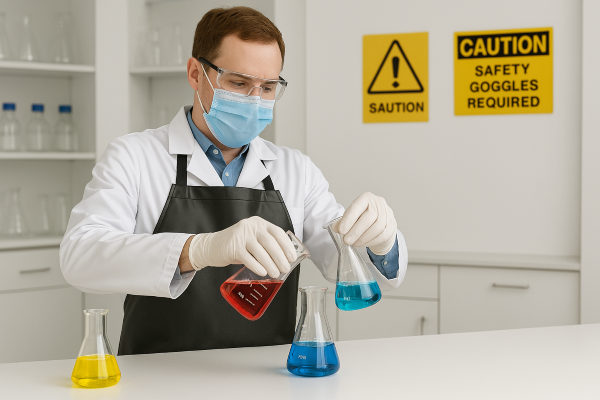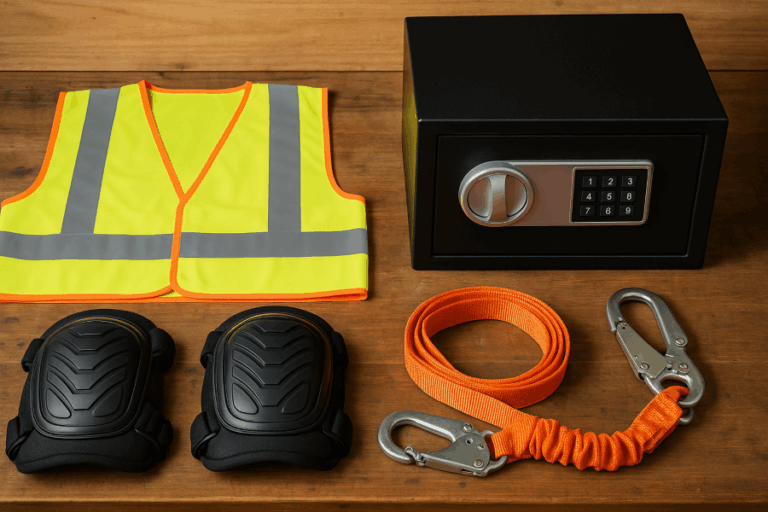Chemical Aprons: The Frontline Protection Against Chemical Spills
👩🔬Why Chemical Aprons Matter More Than You Think
When working in a lab, a factory, or any environment that involves hazardous chemicals, one small spill can lead to major consequences — from skin burns and ruined clothes to serious injuries. That’s why chemical aprons are an essential layer of personal protective equipment (PPE).
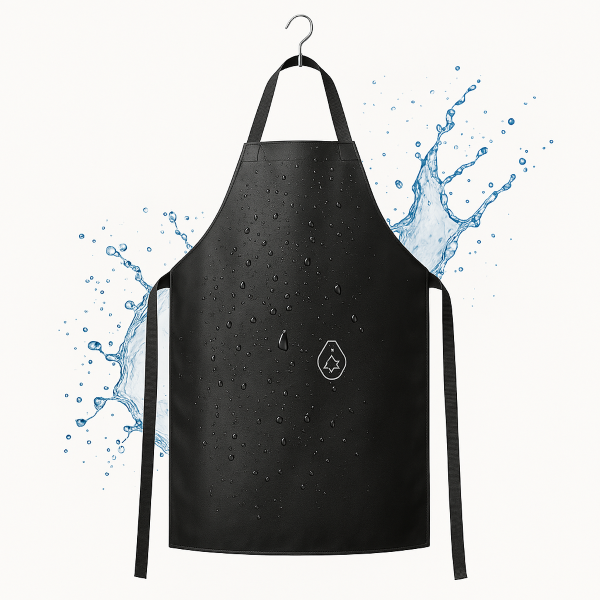
A good chemical apron does more than just keep your clothes clean — it creates a barrier between your body and potentially harmful substances. In this guide, we’re going to break down everything you need to know about chemical aprons, including:
- What they are and what they’re made of
- Which industries use them
- How they compare to other PPE
- The top modern products available today
- And how to choose the right one for your work
Let’s jump in (but not without your apron!).
🧴 What Is a Chemical Apron?
A chemical apron is a specialized garment worn over clothing to protect the wearer’s torso and upper legs from liquid chemical spills, splashes, and contact exposure. Most are made of waterproof and chemical-resistant materials that act as a shield between the body and hazardous substances.
| Feature | Description |
|---|---|
| Material | PVC, neoprene, polyethylene, nitrile, or rubberized fabric |
| Primary Function | Protection against spills, splashes, and corrosive liquids |
| Common Use Cases | Labs, chemical plants, janitorial work, industrial cleaning |
| Other Features | Adjustable straps, resistance to wear, some are flame-resistant |
These aprons are often used in conjunction with gloves, face shields, goggles, and chemical-resistant suits to provide full-body protection.
🏭 Who Uses Chemical Aprons?
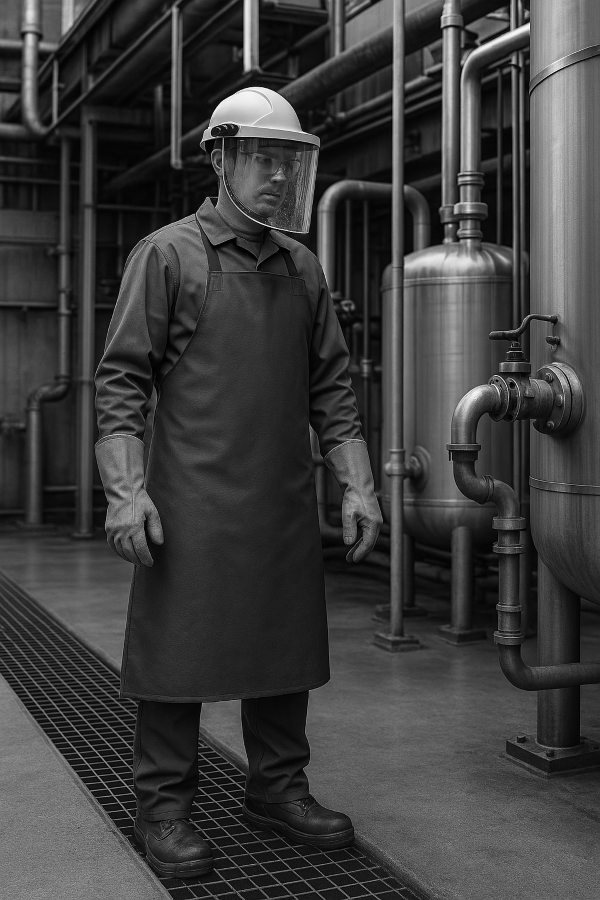
Chemical aprons are used in a wide range of industries, including but not limited to:
- Chemical Manufacturing
- Pharmaceuticals
- Laboratory Research
- Food Processing (sanitizers, degreasers)
- Janitorial and Sanitation Services
- Automotive (battery acid, brake fluid)
- Oil and Gas Industry
- Pest Control and Agriculture (fertilizers, pesticides)
Basically, if you’re handling acids, alkalis, solvents, detergents, or corrosives, you need a barrier between you and disaster — and that’s where these aprons come in.
🧵 Materials That Make the Difference
Not all chemical aprons are made equal. The type of material directly affects the apron’s resistance, comfort, and durability. Here’s a breakdown:
| Material | Chemical Resistance | Flexibility | Durability | Water Resistance | Flame Resistance |
|---|---|---|---|---|---|
| PVC (Polyvinyl Chloride) | Good | Medium | Good | Excellent | Low |
| Neoprene | Excellent | High | High | Excellent | Moderate |
| Nitrile | Good | Medium | Good | Excellent | Low |
| Polyethylene | Good | Low | Medium | Excellent | Low |
| Rubber-coated Fabric | Excellent | Medium | Very High | Very Good | Some |
💡 Pro tip: When choosing a chemical apron, always match the material type with the chemical you’re handling. No one-size-fits-all solution here.
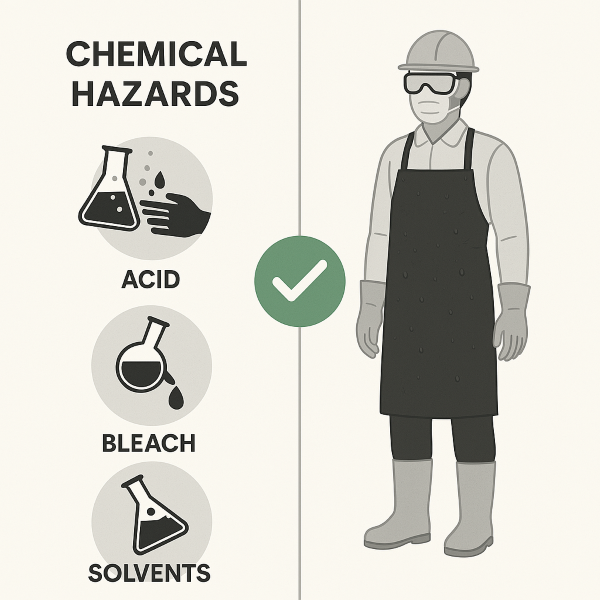
🛠️ Best Modern Chemical Aprons: Product Picks
Below are some of the top-rated chemical-resistant aprons available today. Whether you’re in a lab or a large-scale facility, these aprons offer the right balance of protection, comfort, and cost.
| Product Name | Material | Best For | Features | Price Range |
|---|---|---|---|---|
| Neoprene-Coated Safety Apron | Neoprene | Industrial Chemical Handling | Flame-resistant, chemical-proof | $45–$90 |
| PVC Chemical-Resistant Apron | PVC | Labs, Light Duty | Lightweight, adjustable straps | $20–$40 |
| Rubber-Coated Heavy-Duty Apron | Rubber Blend | Automotive, Sanitation | Acid-resistant, reinforced corners | $35–$70 |
| Polyethylene Disposable Aprons | Polyethylene | Single-use, Lab Settings | Lightweight, low-cost | $10–$25 (packs) |
| Nitrile Hybrid Safety Apron | Nitrile | Food Processing, Cleanrooms | Flexible, splash protection | $25–$50 |
📊 Comparison Chart: Chemical Apron vs. Other Protective Aprons
| Feature | Chemical Apron | Welding Apron | Kitchen Apron | Lab Coat |
|---|---|---|---|---|
| Chemical Resistance | High | Low | Low | Medium |
| Water Resistance | Excellent | Low | Medium | Low |
| Heat Resistance | Low to Medium | High | Low | Medium |
| Coverage Area | Torso and upper legs | Torso and thighs | Mid-torso | Full upper body |
| Use Case | Chemicals, solvents | Heat, sparks | Cooking | Dry lab environments |
| Material Options | PVC, Neoprene, Nitrile | Leather, Kevlar | Cotton, Polyester | Cotton or Poly Blend |
🧼 Maintenance and Cleaning
To maintain both safety and durability, chemical aprons should be cleaned after every use and stored properly.
Cleaning Tips:
- Rinse off spills immediately to prevent chemical absorption.
- Wash with mild detergent and warm water.
- Avoid machine drying—air dry in a ventilated area.
- Inspect regularly for cracks, tears, or degraded material.
⚠️ Important: If your apron comes into contact with corrosive or toxic chemicals, follow your workplace’s decontamination protocols.
🧪 Chemical Apron Safety Tips
Using a chemical apron is only part of the equation. Combine it with the right practices:
✅ Always wear gloves and goggles alongside your apron
✅ Don’t reuse disposable aprons
✅ Replace aprons with signs of degradation or damage
✅ Know which chemicals you’re working with — consult SDS sheets
✅ Tuck the apron securely and adjust straps for tight coverage
❓ Frequently Asked Questions (FAQ)
Q1: Are chemical aprons one-size-fits-all?
A: Most aprons come in adjustable sizes, but for heavy-duty or industrial use, it’s better to buy a size that fits your body comfortably and offers maximum coverage.
Q2: Can I wear a chemical apron for cooking or grilling?
A: Not recommended. Chemical aprons are not designed for food-safe applications and usually aren’t breathable or heat-resistant like grilling aprons.
Q3: Are chemical aprons flame-resistant?
A: Some are, depending on the material. Neoprene and rubber-coated aprons may offer limited flame resistance, but always check product specs.
Q4: What’s the difference between a lab coat and a chemical apron?
A: A lab coat protects more of your upper body and arms, but many are not fully waterproof or chemical-proof. A chemical apron focuses on front-body protection against liquid spills.
Q5: Can chemical aprons be used more than once?
A: Yes, unless it’s labeled “disposable.” Reusable aprons (like neoprene or PVC types) can last months with proper care.
🧠 Conclusion: Cover Yourself Before It Spills
Chemical aprons aren’t just an accessory — they’re your first line of defense in environments where a single splash could mean the difference between a safe shift and a chemical burn.
Whether you’re in a research lab, sanitation department, or chemical processing plant, there’s a chemical apron designed to keep you dry, safe, and compliant. And with modern materials like PVC, neoprene, and nitrile, you don’t have to sacrifice comfort for safety.
So the next time you’re mixing solvents, sanitizing surfaces, or deep-cleaning tanks, remember: your apron might just be the real MVP.
📌 Quick Summary Table
| Feature | Chemical Apron |
|---|---|
| Purpose | Protection against chemical spills/splashes |
| Common Materials | PVC, Neoprene, Nitrile, Rubber |
| Used In | Labs, janitorial work, chemical industries |
| Reusable? | Yes (unless disposable) |
| Price Range | $10–$90 |
| Flame-Resistant Options | Available in neoprene, rubber blends |

